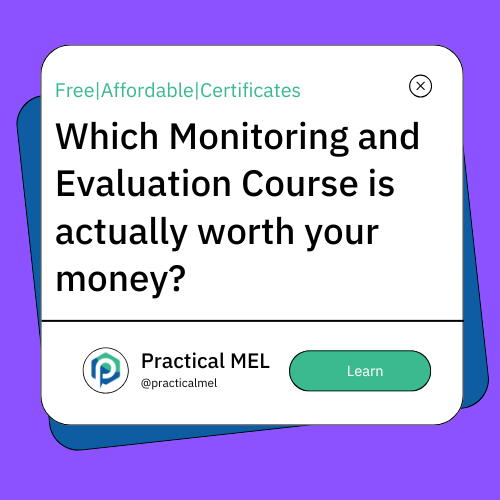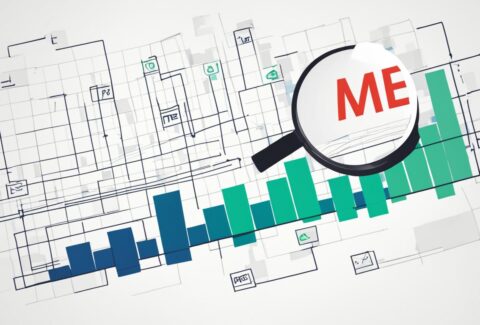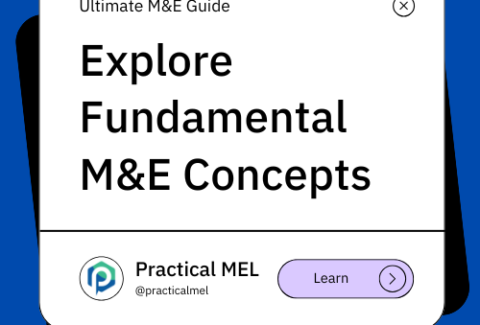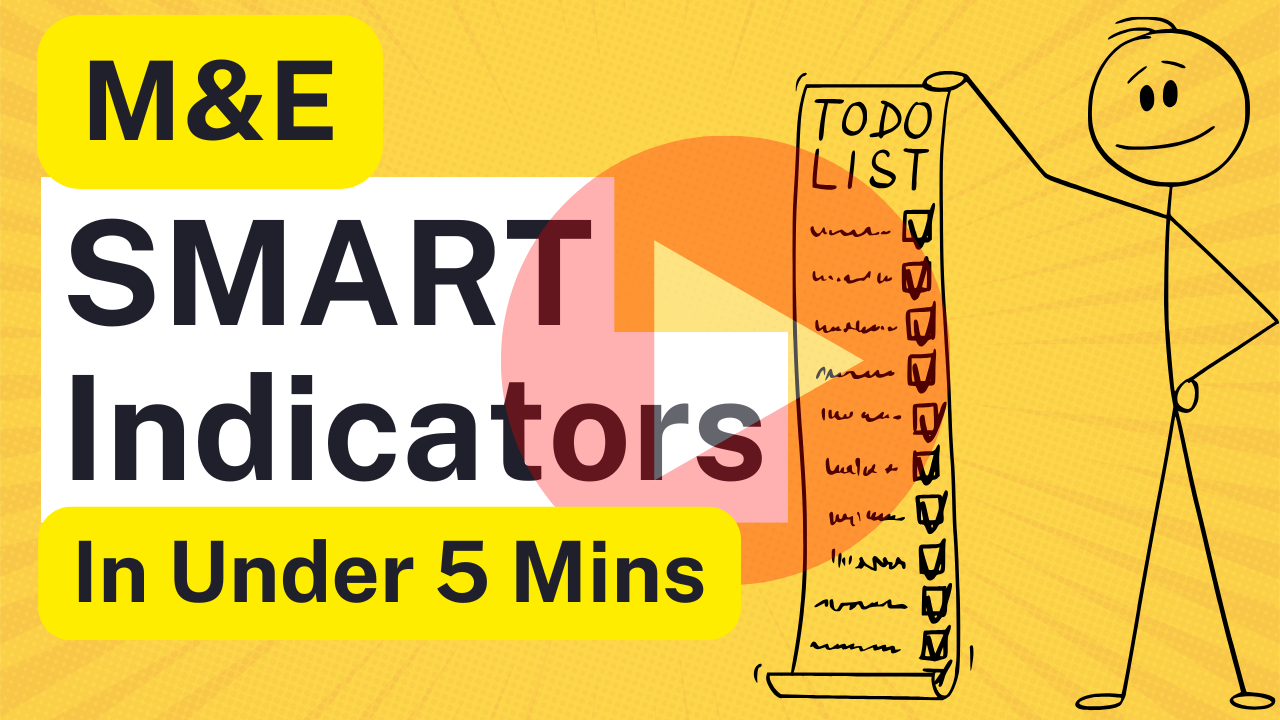Best M&E Course Options Ranked by Value and Career Stage
October 29, 2025 2025-10-29 13:06Best M&E Course Options Ranked by Value and Career Stage
You’re looking at M&E courses and the options are overwhelming. Free courses promise the basics, university certificates cost thousands, and everyone claims their certification will boost your career. But which M&E course actually delivers results?
This guide cuts through the noise. We compared 15+ M&E course options across price, quality, recognition, and real-world value. You’ll learn which courses employers actually care about, which ones waste your time, and how to choose based on where you are in your career right now.
Free M&E course options that don’t waste your time
Free courses aren’t all created equal. Some give you a certificate that means nothing. Others teach outdated methods. But a few free M&E course options genuinely prepare you for entry-level M&E work.
The standout is FHI 360’s course on Philanthropy University. You get a certificate from UC Berkeley’s Haas School of Business – not some random online platform. The course walks you through creating an actual M&E plan for a project. It’s not theory. You build something you can show employers.
Takes about 5-10 hours per week for 4 weeks. The catch? You need to score 50% on assignments to get the certificate. Most people pass, but you actually have to do the work.
If you’ve already taken that one, their second course “From Data Collection to Data Use” goes deeper. It covers the stuff that trips up new M&E professionals – data management systems, analysis techniques, presenting findings to stakeholders who don’t care about your methodology.
Alison’s “Designing and Implementing M&E Systems” is shorter (4-5 hours total) but covers less ground. Good for understanding if M&E interests you before committing to longer training. The certificate costs money though, which defeats the point of a free course.
For sector-specific training, Global Health eLearning Center offers 10 separate courses you can take individually. Each runs about 2 hours. Start with “Monitoring and Evaluation Fundamentals” then pick courses based on your sector. The economic evaluation course is solid if you’re working on large-scale programs.
Here’s what actually matters:
| Course | Time Investment | Real Certificate | Best For |
|---|---|---|---|
| FHI 360 (Philanthropy U) – Planning for M&E | 20-40 hours | Yes (UC Berkeley Haas) | Building your first M&E plan |
| FHI 360 – Data Collection to Use | 20-40 hours | Yes (UC Berkeley Haas) | Implementation skills |
| Alison M&E Systems | 4-5 hours | Paid upgrade only | Testing interest in M&E |
| Global Health eLearning – Individual modules | 2 hours each | Yes | Health sector basics |
| Humanitarian M&E (DisasterReady) | 1-2 hours | Yes | Emergency/crisis contexts |
When free courses make sense: You’re exploring M&E as a career. You need basic skills for a current role. You’re switching from another development sector and want to test the waters.
When you need to pay: You’re actively job hunting and need credentials employers recognize. You’re at mid-career and free courses won’t teach you anything new. Your employer requires specific certifications.
Affordable M&E course platforms that bridge the gap
Between free introductory courses and expensive university certificates, there’s a middle tier that costs $15-80. These M&E course options aren’t as comprehensive as university programs, but they offer more depth than free options and come with recognizable completion certificates.
Udemy runs frequent sales where M&E courses drop to $12-15 (from their listed $80-100 prices). Never pay full price – wait for a sale. They happen weekly.
“From Zero to Hero in Monitoring and Evaluation” by Kithinji Charles is the most popular. 4.3/5 rating from 1,884 students. Covers logical frameworks, M&E methods, tools, and data analysis using Excel. About 6 hours of video content plus worksheets.
Takes most people a weekend to complete if they focus. The instructor worked in M&E for 7+ years across East Africa, so examples come from real projects. Not theory from someone who’s never implemented an M&E system.
“Results-Based Management, Monitoring & Evaluation” from Humanitarian Training goes deeper on the logical framework approach. 4.5/5 rating, 830 students. Better for people who already understand M&E basics and need to master RBM specifically.
4 hours of video, but the exercises take longer. You actually build a logical framework for a sample project. Instructor Neil Kendrick has 25+ years experience training development professionals – his approach is practical, not academic.
For beginners who want comprehensive coverage fast, “Monitoring and Evaluation (M&E) in Development Projects” gives you the essentials in 3 hours. Modules on introduction, logical frameworks, indicators, data collection, and evaluation. Plus bonus content on advanced pivot tables for data analysis.
The instructor has 15 years experience including work with USAID projects. Examples use real project data, not hypothetical scenarios.
Coursera offers “Results-Based Project Management: Monitoring and Evaluation” from University of Witwatersrand. This one costs more ($50-80 depending on whether you buy the individual course or subscribe to Coursera Plus) but you get a university-backed certificate.
Takes 4 weeks at 3-4 hours per week. Not self-paced like Udemy – you follow a schedule with deadlines. Some people like the structure. Others find it annoying when work gets busy.
| Platform | Course | Price Range | Time Investment | Best For |
|---|---|---|---|---|
| Udemy | From Zero to Hero in M&E | $12-15 (on sale) | 6 hours + exercises | Beginners wanting comprehensive foundation |
| Udemy | Results-Based Management M&E | $12-15 (on sale) | 4 hours + exercises | Learning RBM/LogFrame approaches |
| Udemy | M&E in Development Projects | $12-15 (on sale) | 3 hours | Fast overview with data analysis focus |
| Coursera | University of Witwatersrand M&E | $50-80 | 12-16 hours over 4 weeks | University certificate + structured learning |
When these make sense: You’ve completed free courses and want more depth. You learn better from video than reading. You need a certificate that shows you invested time and money (even if modest amounts). You want to learn at your own pace without strict deadlines.
When to skip them: You already work in M&E and need advanced specialization, not foundations. You’re applying to jobs that specifically ask for university credentials. You have access to employer-funded training and shouldn’t spend your own money.
The Udemy courses work best as supplements to free training. Take FHI 360’s free courses first, then fill gaps with targeted Udemy courses on topics you need to strengthen. Don’t buy three different intro courses – pick one based on reviews, then move to advanced topics.
University M&E course programs worth the investment
University certificates cost real money. $4,000 to $6,000 for most programs. The question isn’t whether they’re expensive – they are. The question is whether that investment actually changes your career trajectory.
American University’s certificate stands out for one reason: real project work. Four courses, each requiring you to partner with an actual organization. You don’t just learn theory – you conduct evaluations for NGOs, government agencies, or companies. Takes 8 months minimum.
The catch? You need a bachelor’s degree and ideally a 3.0 GPA. Plus you have to find partner organizations willing to work with you. Some students struggle with this. But graduates walk away with portfolio pieces they can show in interviews.
Credits transfer to their full Master’s program if you decide to continue. That matters if you’re considering a master’s degree later.
NYU’s School of Professional Studies offers a five-course certificate designed for two semesters. Mix of synchronous and asynchronous learning. You’re required to attend 80% of live sessions, so time zones matter if you’re international.
The program covers quantitative and qualitative methods in separate courses – most programs squeeze both into one. If you’re weak on stats, this helps. Final course is creating an actual M&E report for a target audience.
Clark University runs two tracks: domestic and international development. Choose based on where you want to work. The domestic track focuses on US-based community development. International track covers typical development work.
Unique feature: partnerships with health, education and human services organizations give you access to practicing evaluators. Not just professors. People doing this work daily.
Duke’s program (offered through their Center for International Development) is shorter but intensive. Runs October through November. Live classes three times per week for 9am-12pm ET. If you can’t attend live, this won’t work – recordings aren’t the same.
Faculty includes current World Bank and IMF staff. You’re learning from people designing evaluation systems for billion-dollar programs. The price matches: this is one of the more expensive options.
Here’s what you’re actually buying:
| Program | Duration | Cost Range | Key Differentiator | Credits Transfer to Masters |
|---|---|---|---|---|
| American University | 8 months | ~$4,000-5,000 | Required practicum with real organizations | Yes (MS in Measurement & Evaluation) |
| NYU School of Professional Studies | 2 semesters | Contact for pricing | Separate quant/qual methods courses | Yes (potential pathway) |
| Clark University | Varies | ~$4,000-6,000 | Domestic or international track choice | Yes (MA in Sustainability & Social Justice) |
| Duke DCID | 4 weeks intensive | Higher tier | World Bank/IMF faculty | No (standalone) |
The real question: does this investment pay off?
If you’re switching careers into M&E, yes. Employers in international development recognize these names. American University especially – it’s in DC where most development organizations headquarter.
If you’re already working in M&E and want to formalize your skills, maybe. Depends on your employer. Some organizations care about credentials. Others care about what you can do.
If you’re a recent graduate with no work experience, no. Get a job first, even if it’s entry-level. Real project experience matters more than another certificate on top of your bachelor’s degree.
The practicum requirement is actually the most valuable part – and it’s free with the real-world jobs you should be pursuing instead.
Specialized certifications for specific sectors
General M&E skills get you in the door. Sector specialization gets you the job offer.
Global Health M&E is different from education M&E. The indicators differ. The data collection methods differ. The stakeholders speak different languages. If you know you’re working in health, sector-specific training saves you months of learning on the job.
The Global Health eLearning Center’s full certificate (10 courses, about 20 hours total) covers health-specific challenges. Disease surveillance. Clinical trial monitoring. Health information systems. Things that don’t matter in education projects but are critical in health work.
Free, but you have to complete all 10 courses. Most people take 2-3 months. The economic evaluation course alone is worth it if you’re working on cost-effectiveness studies.
For humanitarian work, MEAL (Monitoring, Evaluation, Accountability & Learning) adds accountability mechanisms you won’t find in traditional M&E. Important when you’re distributing aid in crisis settings. DisasterReady offers short courses (1-2 hours each) covering basics. Not comprehensive, but enough to understand what makes humanitarian M&E different.
The International Training Centre (ITC-ILO) runs a full certification program that’s actually recognized globally. It’s the training arm of the UN’s International Labour Organization. Eight-week online program covering M&E systems, theory, approaches, techniques and tools.
Not cheap – typically runs several hundred dollars. But it’s one of the few M&E credentials that actually means something internationally. You get permanent access to training materials and a toolkit. The UN connection matters when you’re job hunting.
When to specialize:
Start general if you’re not sure which sector you’ll work in. Take FHI 360’s free courses first. Once you land a job or know your sector focus, then invest in specialized training.
Go directly to specialized training if you’re already working in a sector. A nurse moving into health program management doesn’t need M&E fundamentals – they need to understand how M&E applies in health settings specifically.
Skip specialization entirely if you’re consulting across sectors. Generalist skills serve you better when clients come from different industries.
Professional certifications and what they signal
There’s no universal M&E credential like CPA for accounting or PE for engineering. That’s actually useful information – it means you’re not behind if you don’t have one.
The Certified Evaluation Professional (CEP) from Claremont Graduate University comes closest to an industry standard. But “closest” is doing heavy lifting there.
Requires 30 days of training. First 15 days cover 11 required courses. Next 9 days are design and analysis electives. Final 6 days focus on practice and inquiry. It’s intensive. Most people take it over several months rather than consecutively.
Cost runs $1,500-2,500 per course depending on format. For the full CEP you’re looking at $15,000-25,000 if you pay course by course. Some people spread this over years. Others never complete it and just take the courses they need.
Here’s the reality: the courses are more valuable than the credential. Employers don’t specifically ask for CEP. They ask for evaluation skills. If you can demonstrate those skills through project work, the letters after your name matter less.
The CMEP (Certified Monitoring and Evaluation Professional) through organizations like AIBM is newer. Less widely recognized. Covers similar ground – M&E fundamentals, framework development, data analysis. More affordable than CEP but also less established.
What these credentials actually signal:
To employers: You invested in professional development. You understand formal evaluation methodologies. You can speak the technical language.
What they don’t signal: That you can actually do the work. Certifications prove you passed courses, not that you can design an evaluation under budget constraints with uncooperative partners.
The math is straightforward. Professional certifications cost $2,000-25,000. University certificates cost $4,000-6,000 and often include more practical work. Unless you specifically need the CEP for a job requirement (some consulting firms prefer it), university certificates give you more value per dollar.
When professional certifications make sense:
- Your employer is paying
- You’re senior-level and want to formalize 10+ years of experience
- You’re consulting and clients specifically request these credentials
- You’re teaching evaluation and want the formal background
When they don’t:
- You’re entry or mid-level (your money is better spent on university certificates with practicum requirements)
- You’re job hunting and need credentials employers actually ask for
- You’re on a tight budget
How to choose the right M&E course for your career stage
Your career stage determines which M&E course actually helps you.
If you’re exploring whether M&E is right for you:
Start with Alison’s 4-5 hour M&E course. Costs nothing except time. If you finish and want more, take FHI 360’s Planning for Monitoring and Evaluation course on Philanthropy University. Still free, but longer commitment (20-40 hours).
Don’t pay for anything yet. Most people who think they want to do M&E discover they actually prefer implementation work or research. Figure out if you like this work before spending money.
If you’re job hunting after graduating:
American University’s certificate if you’re in the US or targeting US-based development organizations. The DC location and practicum requirement give you something to talk about in interviews beyond “I took courses.”
NYU’s certificate if you’re targeting private sector or consulting. The quantitative methods focus matters more in corporate environments.
Budget 8 months and $4,000-5,000. Yes that’s expensive. But it’s cheaper than a master’s degree and faster than hoping someone hires you without credentials.
If you’re switching careers into M&E:
Take the free FHI 360 courses first to make sure you like the work. If you complete both (Planning and Data Collection to Use) and still want to continue, then invest in a university certificate.
For affordable depth-building, add one of the highly-rated Udemy courses ($12-15 during sales). “From Zero to Hero in Monitoring and Evaluation” works well after completing free introductory courses – it reinforces concepts with different examples and gives you Excel-based data analysis practice.
Clark University’s certificate works well for career switchers because you choose domestic or international track. If you’re coming from US social services, the domestic track applies immediately.
If you’re already working in M&E informally:
The ITC-ILO certification gives you credentials that translate globally. Especially useful if you’re working for international organizations or planning to work abroad.
For quick skill-building without major time commitment, the Coursera University of Witwatersrand course ($50-80) provides university-backed credentials in 4 weeks. Better ROI than free courses if you need something recognized on your CV now.
Global Health eLearning if you’re in health sector. It’s free and directly applicable. Spend your money on advanced statistics courses instead.
If you’re advancing in your current M&E role:
Specialized sector courses make sense. You already know M&E fundamentals – you need to know how they apply in your specific context.
The “Results-Based Management, Monitoring & Evaluation” Udemy course (4.5 rating) helps if you’re moving into senior roles requiring RBM expertise. $12-15 investment for practical LogFrame mastery.
Skip general certificates. Your work experience is worth more than another generalist credential.
Three mistakes to avoid
Paying for courses before testing fit. Free options exist. Use them. Spending $5,000 to discover you hate M&E is expensive.
Choosing based on brand name over content. A prestigious university certificate means nothing if it doesn’t teach skills your target employers want. American University works because development organizations are in DC. Duke works because it’s connected to multilateral agencies. Random Ivy League business school certificate? Probably wrong fit.
Collecting certificates instead of doing work. After your first certificate, real project experience matters more. If you’re choosing between a second certificate and taking a lower-paying job that involves actual M&E work, take the job.
The bottom line: start free, invest strategically based on where you want to work, then stop taking courses and start doing the work.
Ready to start your M&E education?
Free courses (start here):
- Enroll in FHI 360’s Planning for M&E course (Best free starting point)
- Check out Global Health eLearning Center (Free health-sector specialization)
Affordable depth-building ($12-80):
- From Zero to Hero in Monitoring and Evaluation on Udemy (4.3★ – comprehensive 6-hour course)
- Results-Based Management M&E on Udemy (4.5★ – LogFrame focus)
- University of Witwatersrand M&E course on Coursera (University certificate in 4 weeks)
University certificates (when you’re ready to invest $4k+):
- Explore American University’s certificate program (DC-based with required practicum)
For more M&E resources, check out our complete M&E framework development guide and our SMART indicators library with 200+ ready-to-use examples.










